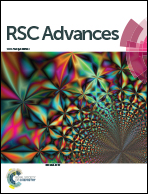Microbial resistant nanocurcumin-gelatin-cellulose fibers for advanced medical applications
Abstract
Curcumin, a greatly potent, non-toxic and naturally existing bioactive material in turmeric is widely employed to develop biomedical functional materials due to its environmental friendly nature. In general, curcumin functional materials were prepared by administrating non-aqueous solvents as a dissolving medium for curcumin. These non-aqueous solvents cause adverse effects for the environment and humans. However, if the curcumin functional materials are developed based on aqueous solution then the adverse effects can be eliminated. In view of this, for the first time aqueous based nanocurcumin (nanoparticles of curcumin) impregnated gelatin cellulose fibers (NCGCFs) were developed by a green process. The required nanocurcumin was prepared by ultrasonication process. Transmission electron microscopy showed the sizes of nanocurcumin exist in the range ∼2 to 15 nm. Nuclear magnetic resonance spectra showed no structural modification of nanocurcumin to that of curcumin. The developed fibres were characterized by fourier transform infrared spectroscopy, scanning electron microscopy, thermal analysis and swelling studies. Cumulative releasing studies showed slow and sustained releasing patterns for NCGCFs. A comparative antimicrobial study was performed for nanocurcumin impregnated gelatin cellulose fibres (NCGCFs) and curcumin impregnated gelatin cellulose fibres (CGCFs) against E. coli and S. aureus. The results indicated the superior performance of NCGCFs over CGCFs. Hence, NCGCFs prepared completely from naturally available materials can be considered as a novel kind of functional materials for wound dressing and antimicrobial applications.


 Please wait while we load your content...
Please wait while we load your content...